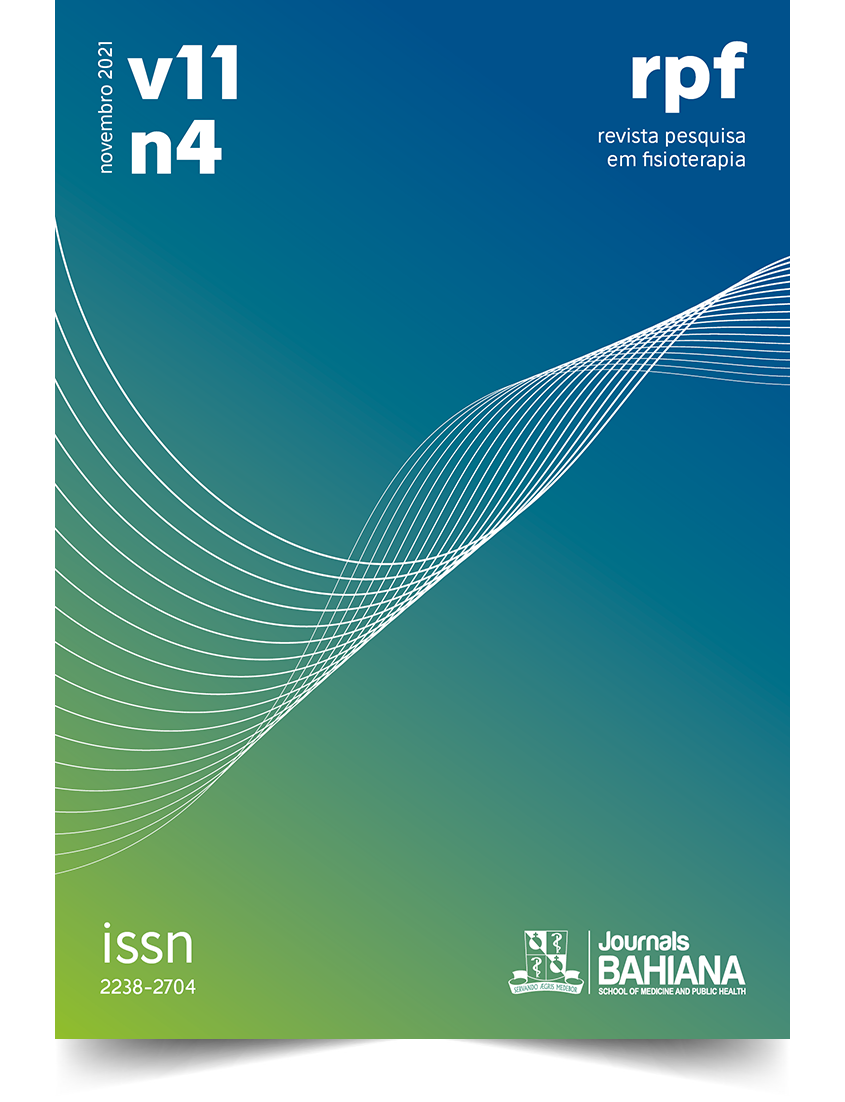Validade e reprodutibilidade do Teste Avaliativo de DTM: um estudo de acurácia diagnóstica
DOI:
https://doi.org/10.17267/2238-2704rpf.v11i4.4153Palavras-chave:
Transtornos da Articulação Temporomandibular, Inquéritos e questionários, Acurácia diagnóstica, Reprodutibilidade dos testesResumo
INTRODUÇÃO: Disfunções temporomandibulares (DTM) são distúrbios na ATM, sendo de origem muscular, articular ou mista, e com íntima relação com alterações posturais. Instrumentos de diagnóstico apresentam lacunas quanto à aplicação clínica e não associam à postura. OBJETIVO: Validar o Teste Avaliativo de DTM (TAvDTM) quanto à acurácia diagnóstica e reprodutibilidade. MATERIAIS E MÉTODOS: Estudo de acurácia diagnóstica com indivíduos entre 18 e 59 anos avaliados pelo Índice Anamnésico de Fonseca (IAF), questionário sociodemográfico e TAvDTM, este último realizado por três examinadores diferentes e treinados. O resultado da categorização do diagnóstico do IAF foi comparado com o resultado do TAvDTM. Para acurácia diagnóstica utilizou-se teste Qui-Quadrado. Valores Preditivos Positivos (VPP) e Negativos (VPN) foram determinados. A reprodutibilidade entre os três examinadores foi feita por meio do Kappa de Cohen, para análise 2x2 e de Fleiss. Todos os testes com significância de 5%. RESULTADOS: Dos 10 participantes avaliados, o IAF identificou 8 com diagnóstico de DTM, enquanto o TAvDTM verificou 9 participantes com presença desta disfunção. A sensibilidade foi de 100%, especificidade de 50%, VPP de 88% e VPN de 50%. O Kappa de Fleiss evidenciou confiabilidade razoável (K = 0,26 [IC 95%: -0,099 – 0,617]; p>0,05). O Kappa de Cohen mostrou reprodutibilidade insignificante entre os avaliadores 1 e 2 (K=-0,11; p>0,05; discordância=80%), e 1 e 3 (K= -0,11; p>0,05; discordância=80%), reprodutibilidade perfeita entre os avaliadores 2 e 3 (K=1,00; p<0,05; concordância=100%). CONCLUSÃO: O TAvDTM apresenta alta sensibilidade e baixa especificidade, porém com baixa capacidade de reprodução até o presente momento.
Downloads
Referências
Costa LM, Medeiros DL, Ries LG, Beretta A, Noronha MA. Assessment of cross-cultural adaptations and measurement properties of self-report outcome measures in Portuguese relevant to temporomandibular disorders: a systematic review. Fisioter Pesqui. 2014;21(2):107–12. https://doi.org/10.1590/1809-2950/35421022014
Nunes AM, Martinez EM, Lopes PRR, Bittencourt MAV, Canedo PMDM. Association between the posterior muscle chain and the temporomandibular disfunction severity. Rev. Ciênc. Méd. Biol [Internet]. 2016;14(3):394. Available from: http://repositorio.ufba.br/ri/handle/ri/23270
Ferreira CLP, Silva MAMR, Felício CM. Signs and symptoms of temporomandibular disorders in women and men. CoDAS. 2016;28(1):17–21. https://doi.org/10.1590/2317-1782/20162014218
Cantero LS, Morales, JDT, Espinosa IA, Rodríguez ET. Temporomandibular disorders found in patients with malocclusions. Rev Cubana Estomatol [Internet]. 2013;50(4):374-87. Available from: http://scielo.sld.cu/scielo.php?script=sci_arttext&pid=S0034-75072013000400005&lng=es
Manfredi APS, Silva AAD, Vendite LL. The sensibility appreciation of the questionnaire for selection of orofacial pain and temporomandibular disorders recommended by the American Academy of Orofacial Pain. Rev Bras Otorrinolaringol. 2001;67(6):763–8. https://doi.org/10.1590/S0034-72992001000600003
Basso D, Corrêa E, Silva AM. Effect of global postural reeducation on body alignment and on clinical status of individuals with temporomandibular disorder associated to postural deviations. Fisioter Pesqui. 2010;17(1):63-8. https://doi.org/10.1590/S1809-29502010000100012
Azato FK, Castillo DB, Coelho TMK, Taciro C, Pereira PZ, Zomerfeld V, et al. Influence of temporomandibular disorders management on pain and global posture. Rev. dor. 2013;14(4):280-3. https://doi.org/10.1590/S1806-00132013000400009
Horak FB. Postural orientation and equilibrium: what do we need to know about neural control of balance to prevent falls?. Age Ageing. 2006;35 (Suppl 2):ii7-ii11. https://doi.org/10.1093/ageing/afl077
Chaves TC, Oliveira AS, Grossi DB. Main instruments for assessing temporomandibular disorders, part I: indices and questionnaires; a contribution to clinicians and researchers. Fisioter Pesqui. 2008;15(1):92–100. https://doi.org/10.1590/S1809-29502008000100015
Cunha SC, Nogueira RVB, Duarte ÂP, Vasconcelos BCE, Almeida RAC. Analysis of helkimo and craniomandibular indexes for temporomandibular disorder diagnosis on rheumatoid arthritis patients. Braz J Otorhinolaryngol. 2007;73(1):19–26. https://doi.org/10.1016/s1808-8694(15)31117-4
Peña G, Díaz W, Flores G, Marinkovic K, Romo F, Schulz R. Agreement between Diagnostic Criteria RDC/TMD and its update DC/TMD, applied to the inflammatory pathology of the Temporomandibular Joint. Rev. Clin. Periodoncia Implantol. Rehabil. 2019;12(2):70–3. http://dx.doi.org/10.4067/S0719-01072019000200070
Pastore GP, Goulart DR, Pastore PR, Prati AJ, Moraers M. Comparison of instruments used to select and classify patients with temporomandibular disorder. Acta Odontol. Latinoam. 2018;31(1):16–22. Cited: PMID: 30056462.
Schwarzenbeck KCSB. Acurácia e correlação de instrumentos de avaliação da disfunção temporomandibular [dissertation] [Internet]. Campinas: Universidade Estadual de Campinas; 2013. Available from: http://bdtd.ibict.br/vufind/Record/CAMP_d0053ab521d7fd7f764a09b9f1cb322f
Landis JR, Koch GG. The measurement of observer agreement for categorical data. Biometrics. 1977;33(1):159-74. Cited: PMID: 843571
Steenks M, TürpJ, de Wijer A. Reliability and Validity of the Diagnostic Criteria for Temporomandibular Disorders Axis I in Clinical and Research Settings: A Critical Appraisal. J Oral Facial Pain Headache. 2018;32(1):7–18. https://doi.org/10.11607/ofph.1704
Campos JADB, Gonçalves DAG, Camparis CM, Speciali JG. Reliability of a questionnaire for diagnosing the severity of temporomandibular disorder. Rev. bras. fisioter. 2009;13(1):8-43. https://doi.org/10.1590/S1413-35552009005000007
Franco-Micheloni AL, Fernandes G, Gonçalves DAG, Camparis CM. Temporomandibular disorders among Brazilian adolescents: reliability and validity of a screening questionnaire. J. Appl. Oral Sci. 2014;22(4):314-22. https://doi.org/10.1590/1678-775720130694
Alonso-Royo R, Sánchez-Torrelo CM, Ibáñez-Vera AJ, Zagalaz-Anula N, Castellote-Caballero Y, Obrero-Gaitán E, et al. Validity and Reliability of the Helkimo Clinical Dysfunction Index for the Diagnosis of Temporomandibular Disorders. Diagnostics (Basel). 2021;11(3):472. https://doi.org/10.3390/diagnostics11030472
Amantéa DV, Novaes AP, Campolongo GD, Barros TP. The importance of the postural evaluation in patients with temporomandibular joint dysfunction. Acta Ortop Bras. 2004;12(3):155-9. https://doi.org/10.1590/S1413-78522004000300004
Fernández RF, Carter P, Muñoz S, Silva H, Venegas GHO, Cantin M, et al. Evaluation of validity and reliability of a methodology for measuring human postural attitude and its relation to temporomandibular joint disorders. Singapore Med J. 2016;57(4):204-8. https://doi.org/10.11622/smedj.2015159
Downloads
Publicado
Edição
Seção
Licença
Copyright (c) 2021 Yasmin Bianca Oliveira Neri, Ana Carolina Silva Francisco, Isabela Raul Nepomuceno de Jesus, Italo Eduardo Novaes Santos, Rafael Santos Ferreira, Ana Lúcia Barbosa Góes

Este trabalho está licenciado sob uma licença Creative Commons Attribution 4.0 International License.
Esta obra está licenciada com uma Licença Creative Commons Atribuição 4.0 Internacional.



